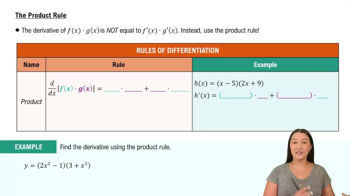Table of contents
- 0. Functions7h 52m
- Introduction to Functions16m
- Piecewise Functions10m
- Properties of Functions9m
- Common Functions1h 8m
- Transformations5m
- Combining Functions27m
- Exponent rules32m
- Exponential Functions28m
- Logarithmic Functions24m
- Properties of Logarithms34m
- Exponential & Logarithmic Equations35m
- Introduction to Trigonometric Functions38m
- Graphs of Trigonometric Functions44m
- Trigonometric Identities47m
- Inverse Trigonometric Functions48m
- 1. Limits and Continuity2h 2m
- 2. Intro to Derivatives1h 33m
- 3. Techniques of Differentiation3h 18m
- 4. Applications of Derivatives2h 38m
- 5. Graphical Applications of Derivatives6h 2m
- 6. Derivatives of Inverse, Exponential, & Logarithmic Functions2h 37m
- 7. Antiderivatives & Indefinite Integrals1h 26m
- 8. Definite Integrals4h 44m
- 9. Graphical Applications of Integrals2h 27m
- 10. Physics Applications of Integrals 2h 22m
3. Techniques of Differentiation
The Chain Rule
Problem 3.57g
Textbook Question
Suppose that functions ƒ(x) and g(x) and their first derivatives have the following values at x = 0 and x = 1.
x ƒ(x) g(x) ƒ'(x) g'(x)
0 1 1 -3 1/2
1 3 5 1/2 -4
Find the first derivatives of the following combinations at the given value of x.
g. ƒ(x + g(x)), x = 0
 Verified step by step guidance
Verified step by step guidance1
To find the derivative of the composite function ƒ(x + g(x)), we will use the chain rule. The chain rule states that if you have a composite function h(x) = ƒ(u(x)), then the derivative h'(x) is ƒ'(u(x)) * u'(x).
In this problem, the outer function is ƒ and the inner function is u(x) = x + g(x). Therefore, we need to find the derivative of the inner function u(x) first.
The derivative of u(x) = x + g(x) is u'(x) = 1 + g'(x).
Now, apply the chain rule: the derivative of ƒ(x + g(x)) is ƒ'(x + g(x)) * (1 + g'(x)).
Evaluate this expression at x = 0 using the given values: ƒ'(x + g(x)) at x = 0 is ƒ'(0 + g(0)) = ƒ'(1), and 1 + g'(0) is 1 + 1/2. Use these values to find the derivative at x = 0.
 Verified video answer for a similar problem:
Verified video answer for a similar problem:This video solution was recommended by our tutors as helpful for the problem above
Video duration:
3mPlay a video:
Was this helpful?
Key Concepts
Here are the essential concepts you must grasp in order to answer the question correctly.
Chain Rule
The Chain Rule is a fundamental principle in calculus used to differentiate composite functions. It states that if you have a function that is composed of two functions, say f(g(x)), the derivative is found by multiplying the derivative of the outer function evaluated at the inner function by the derivative of the inner function. This rule is essential for solving problems involving functions of functions, such as g.ƒ(x + g(x)).
Recommended video:

Intro to the Chain Rule
Product Rule
The Product Rule is another important differentiation rule that applies when differentiating the product of two functions. It states that if you have two functions u(x) and v(x), the derivative of their product u(x)v(x) is given by u'(x)v(x) + u(x)v'(x). This concept is crucial when dealing with expressions that involve products of functions, especially when evaluating derivatives at specific points.
Recommended video:

The Product Rule
Evaluating Derivatives at Specific Points
Evaluating derivatives at specific points involves substituting a particular value of x into the derivative function to find the slope of the tangent line at that point. This process is vital for understanding the behavior of functions at specific locations, such as determining the rate of change of g.ƒ(x + g(x)) at x = 0. It requires knowledge of both the function and its derivative values at the given points.
Recommended video:

Critical Points

 5:02m
5:02mWatch next
Master Intro to the Chain Rule with a bite sized video explanation from Callie
Start learningRelated Videos
Related Practice






